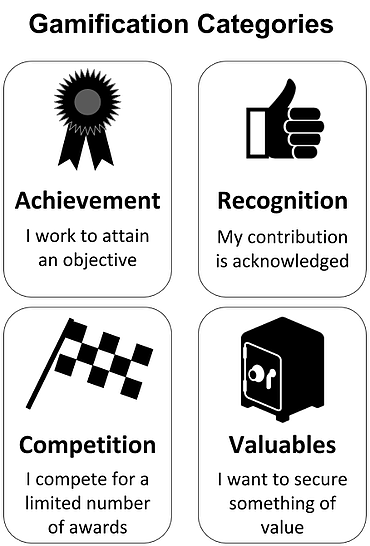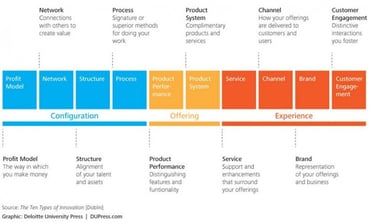The history of management is littered with outmoded fads, those tools that seem to have a short shelf-life. There are a few that are seemingly enduring, but one that perhaps does endure is the Baldrige Excellence Framework. Since its inception in 1988 thousands of organizations around the world have used the framework to improve their organization's effectiveness and achieve sustaining results. It has gone through its own evolving path to continue to adjust and stay relevant by changing or constantly adjusting its criteria every two years. It aims to be a leading edge of validated management practice, and we'll come back to whether that is the case later in this review.
Explaining the basics of Baldrige
Baldrige has a simple purpose: to provide the framework to help your organization, no matter its size or type (business, non-profit, education, government, healthcare) covering manufacturing, service, small businesses alike, focusing on knowing the critical aspects of managing and performing as an organization. It builds around an integrated performance management framework that the whole organization engages with, to improve overall performance and strive towards excellence.
The value is that Baldrige is intentionally non-prescriptive. It does not tell leaders how to manage their organizations. There are no two organizations alike – organizations operate in different environments, even in the same industry or market, are pursuing different strategies; they have different core competencies; and they are addressing different strategic challenges (internally and externally). Organizations assess their own system against the detailed material available. This works through the foundation criteria for performance excellence based on seven categories, six of which represent a collection of processes and the seventh represents outcomes.
I have taken the Health Care Baldrige Excellence Framework here as it does an excellent job of describing its essential parts and the system perspective that all Baldrige Excellence Frameworks work towards.
The framework has been both consistent and evolving in its criteria
Over all the years the criteria characteristics, goals and purpose has remained constant, but within these they have evolved significantly over time to keep relevant to the current economic and marketplace challenges and opportunities. I’ll highlight these progressive adjustments later.
The importance with these Criteria Characteristics are to:
- focus on results in all areas of performance to ensure all strategies are balanced,
- are non-prescriptive and adaptable to promote creative and flexible approaches to foster incremental and breakthrough improvements,
- support a systematic perspective to maintain organization-wide goal alignment,
- support goal-based diagnosis, based on a profile of performance orientated strengths and opportunities to improve.
This integrated approach has three basic goals:
- delivery of ever-improving value to customers, contributing to marketplace success,
- improvement of overall organization effectiveness and in the capabilities,
- provide organizational and personal learning.
It is all about self-improvement to improve practices, capabilities and results and serve as a working tool for understanding and managing performance, and provide the common language mechanism to discuss it, both internally and externally for learning.
So, what makes up categories?
Seven categories make up the award criteria:
- Leadership—Examines how senior executives guide and sustain the organization and how the organization addresses governance, ethical, legal and community responsibilities.
- Strategic planning—Examines how the organization sets strategic directions and how it determines and deploys key action plans.
- Customer focus—Examines how the organization determines requirements and expectations of customers and markets; builds relationships with customers; and acquires, satisfies, and retains customers.
- Measurement, analysis, and knowledge management—Examines the management, use, analysis, and improvement of data and information to support key organization processes as well as how the organization reviews its performance.
- Workforce focus—Examines how the organization engages, manages, and develops all those actively involved in accomplishing the work of the organization to develop full potential and how the workforce is aligned with the organization’s objectives.
- Process management—Examines aspects of how key production/delivery and support processes are designed, managed, and improved.
- Results—Examines the organization’s performance and improvement in its key business areas: customer satisfaction, financial and marketplace performance, workforce, product/service, and operational effectiveness, and leadership. The category also examines how the organization performs relative to competitors.
It's the Core Values and Concepts that have the critical value
The Criteria are built on a set of interrelated, embedded beliefs and behaviours found in high-performing organizations. The core values and concepts are the foundation for integrating key business requirements within a results-oriented framework that creates a basis for action and feedback.
Baldrige Core Values and Concepts
- Visionary Leadership
- Customer-Driven Excellence
- Organizational and Personal Learning
- Valuing Workforce and Partners
- Agility
- Focus on the Future
- Managing for Innovation
- Management by Fact
- Societal Responsibility
- Focus on Results and Creating Value
- Systems Perspective
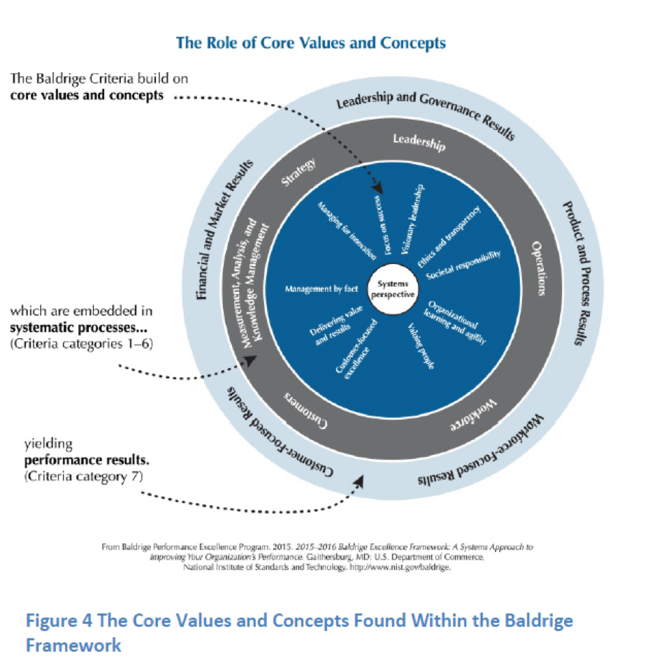
What are benefits compared to other tools and management systems?
Baldrige set out on a true systems perspective – it looks at all components of an organization with equal emphasis and focuses on how each part impacts and links with the others. It helps leaders align and integrate their leadership, strategy, customer & market focus, data analysis & knowledge management, workforce, and process management systems to produce the best overall results.
It is important to recognize most other tools and management systems focus on one or a few of these components more than the rest. Sometimes applying a tool in one part of the organization has a knock-on effect on another. The value of all the tools and management systems that you deem to be of value complement Baldrige, and they can provide more detailed guidance on the pursuit of the how to implement than what Baldrige does.
Using Baldrige as your management system will help you determine which of these tools will most benefit your organization and when. Often organizations align Lean, Six Sigma, different ISO series such as ISO9000, 9001, 9004 and 31000 – dealing with risk management. They often align it to the balanced scorecard and sometimes to a plan-do-check-act (PDCA).
The choice is what is the most suitable and effective to deploy in making improvements and moving towards excellence. The Baldrige Criteria offer an organization-wide perspective that optimizes an entire system rather than just focuses on pockets of excellence and that needs the consideration before you jump into selected tools that push the problem elsewhere perhaps.
Baldrige works if and only if:
1) Leaders and the organization have the willingness and ability to develop an organizational culture based on the 11 core values of high performing organizations defined by the Criteria.
2) Leaders and the organization are willing to commit to a long-term journey of continuous learning and improvement.
The global perspective
Baldrige grew out of the need to fix US competitiveness in the 1980’s and 90’s. It started with a significant emphasis on quality and has been caught up in that legacy although the quality emphasis has been reduced significantly down in its (overarching) emphasis and its contribution to the eventual scoring you undertake across the different dimensions.
Other countries have adopted their own ‘tailored’ excellence models. In Europe, we have the European Foundation for Quality Management (EFQM), in Singapore, Japan, Canada, Australia and a host of others.
The EFQM model consists of six process enablers and one results category
I believe the EFQM model has been more agile and flexible in its appeal and positioning, perhaps it is engaging far more in the different communities and making the excellence journey more up to date in its relevance and relationships.
EFQM model
- Leadership
- Policy and Strategy
- People
- Partnerships and Resources
- Processes
- Customer Results
- People Results
- Society Results
- Key Performance Results
The fundamental concepts of EFQM include:
- Results orientation
- Customer focus
- Leadership and constancy of purpose
- Management by processes and facts
- People development and involvement
- Continuous learning, innovation and improvement
- Partnership development
- Public responsibility
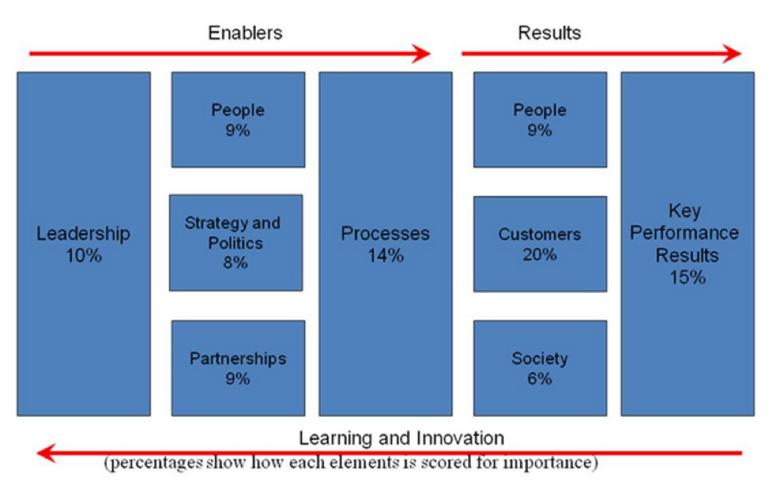
Visual: The EFQM model showing % for each elements score
To ensure sustainable financial growth, we need to keep our customers satisfied. To do this, we need to develop and deliver products & services that add value to them. We also need to deliver excellent service to maximise retention, loyalty and our reputation.
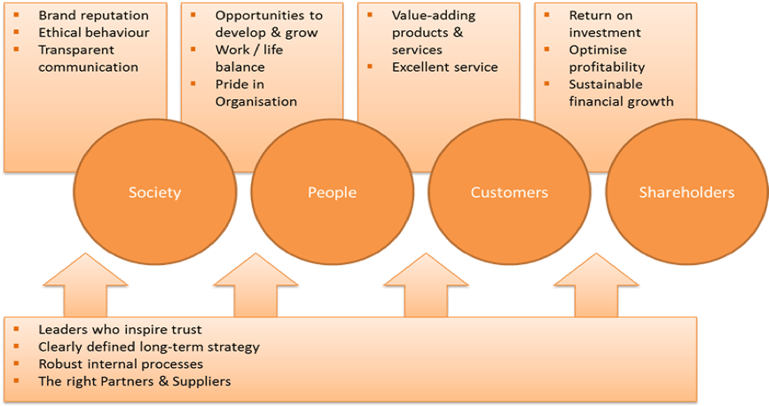
The National bodies coordinate their excellence frameworks through GEM- a global body
In general, business excellence models have been developed by National bodies as their award for contributions to improving national economic performance. In the US they operate on local, regional and national levels where you can keep moving towards a ‘world class level of performance’.
There are nearly 80 countries operating a business excellence award programme at national level and coordinate their learning, work and changes in regular Global Excellence Model meetings. As a council made up of many of the National bodies looking to enhance their frameworks by discussing latest global management trends, it allows for constant advancement in development and rigour to then feed this into the framework to reflect these shifts in orderly ways.
All of them work on the excellent principle of asking the questions all high performing organizations need to consider and leaves the answers to those who can determine them – the people who work in the organization. When they feel progress is made they can seek out an independent Excellence judge to evaluate or even assist them to move the position forward.
There is no question organizations need these systems, even though that is being openly debated. They need a way to better understand how processes are currently working and a systematic pathway to make change and to create new value for customers and internally through the learning.
Returning to the changes in criteria over the years within the Baldrige Framework
Each year since its 1988 inception the Baldrige Award has seen incremental changes in criteria. This has steadily moved away from the ideas of quality management and quality engineering and the emphasis on “pure play” quality. The weighting to the criteria equally changed, reduced, increased depending on the judgement of a significant panel of assessors with organization and excellence judges to adjust to. For example, the 2017-2018 criteria has introduced cybersecurity and enterprise risk management.
Also, each of the criteria categories have been re-organized, duplications removed, improved and provided levels of greater clarity, with some aspects being moved into different categories.
The criteria are still based on the three fundamental questions that need to be constantly asked:
- how can I tell if my organization is doing as well as it could?
- how do I know? And
- what should I (we) improve?
Understanding the WHAT and searching for the HOW
The criteria provided only tells you WHAT. As these are non-prescriptive they will not tell you the HOW. Each organization has to work through their own ‘how’.
For the HOW you need to learn, often from others, in seeking out best practice benchmarking but then evaluating if it fits your journey. The real value of seeking out your HOW is asking a series of questions:
- are the approaches systematic?
- deployable in my organization?
- show evidence of learning for us?
- show integration on what we have giving greater opportunity for alignment?
Having experience myself on this, it is a tough journey to undertake. It needs board commitment and involvement. It needs organization focus, otherwise it does not work.
The more complex your organization, the more diverse across markets, the more fragmented in different market positioning and maturity really makes this incredibly hard to coordinate and drive. For truly global organizations the best advice is ‘go bite sized’ by distinct divisions, subsidiaries, discreet entities where performance might be lagging and this focus through Baldrige raises it significantly and the results can be seen by all as having a measurable impact.
Knowing how to measure and judge progress
To measure this investment and effort you need a focus on process progress within four basic criteria:
- approach accomplishment and how it is effective,
- deployment consistency and relevance,
- learning so knowledge has led to innovation and sharing and finally,
- integration in the complement and harmonization across your organization to achieve organization-wide goals.
Then you need a focus on results. Your view, the internal view, the external view and the future view. A suggested four dimensions are: levels in a meaningful measurement scale, trends in are they improving or not, comparisons against others and finally, integration of all the stakeholders needs to help in decision making for all.
A further focus on linkages. These are all about connections within your process and the results you are achieving, the strategic planning and actual planning process for improving operations, between workforce planning and strategic planning, the customer and market knowledge linking to your strategy and action plans. And finally, the connections between your action plans and the changes you need in your work systems. These need to be dynamic, systematic and well worked through to improve on the existing.
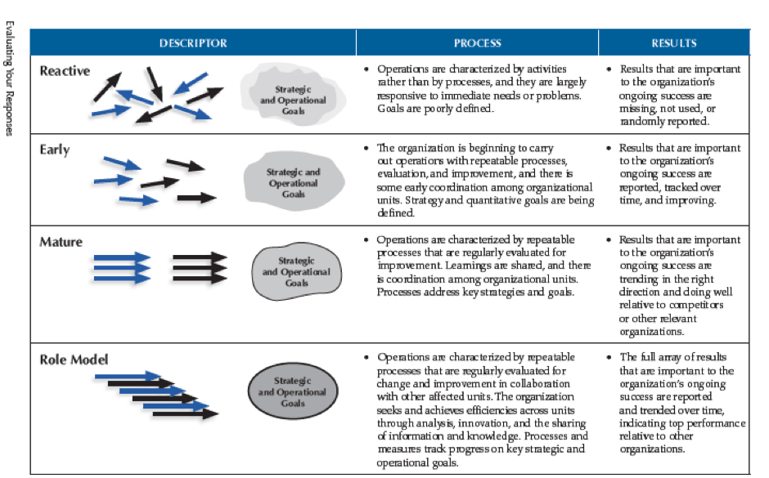
The journey of excellence
The Criteria are used to assess an organization's performance, helping the organization identify its strengths, opportunities for improvement, and gaps/blind spots. An assessment against the Baldrige Criteria has three elements:
- In the Organizational Profile, the organization describes what is important to it (its operating environment, key relationships, competitive environment, and strategic context).
- In responses to categories 1–7, the organization tells how it is accomplishing what is important to it.
- The scoring guidelines allow the organization to assess how well it is accomplishing what is important to it: the maturity of processes and their deployment, and the breadth and significance of the organization’s results.
Responses to the Criteria questions serve as an application for the Baldrige Award and are used internally by organizations to self-assess their own performance. Individual categories or items of the Criteria can be used as a focused study for personal or organizational learning, and many organizations seek leadership development training in the Criteria.
Finally, is the Baldrige Framework as relevant today?
In some ways, the Baldrige programme is at the crossroads. The business entity is less inclined to invest the resource, time and effort into this. The US government support for this has been ‘zeroed-out’, free products offered are no longer viable. Increasingly Baldrige is utilizing a fee-based system to help finance the programme and its ongoing management. Presently it is not getting enough revenue. It is developing partnership programmes and trying to establish a long-term financial viability. The EFQM has far more funding, which is why it presently seems to have expanded its appeal across a more commercial range of frameworks.
For the Baldrige Framework, they need not just funding but rethinking their own excellence framework. The past endowments are running down although most of the major US business and Service Sectors have been highly supportive, but it needs a sense of renewal itself. The argument is Baldrige needs to expand access and reach, not contract. More business, education, health care, non-profit and government organizations need this ongoing access, more need to see the value of the excellence framework and invest in it. Will this happen? At present the Healthcare and Education sectors are investing in this excellence journey through the Baldrige framework. It seems business is far more reluctant to ‘invest’ the time and energy into this at present. Will that change?
Today America is trying to regain its position in the world, under the President Trump banner of “America first” is it recognizing the reality of how this once most powerful nation in the world has slipped. They have some harsh realities to address.
Consider this data from the 2012-2013 World Economic Forum Competitiveness Report. The United States ranks:
- 7th in overall global competitiveness, falling from 1st in 2007
- 12th in prosperity amongst a league of 142 countries representing
- 96% of the world’s population and 99% of global GDP
- 8th in income mobility, falling from 1st place in terms of doing better than our parents
With education, there are even more concerns
The U.S. education infrastructure ranks 23rd, well behind every major developed economy, according to the Organization for Economic Cooperation and Development (OECD). Our 15-year-olds rank 17th in science and 25th in math, while the quality of America’s math and science education ranks 48th. Furthermore, the U.S. ranks 12th in college graduation rates, down from being number one four decades.
And Americans don’t receive an adequate return on health care spending. The U.S. spends 47% more of its GDP on health care than the next highest-ranking country, say studies by the OECD and the World Health Organization. Yet, the U.S. ranks 27th in longer life expectancy and 29th in infant mortality. Since 2008, the cost of private health insurance jumped 59% and one-third of adults are not getting medical care and/or filling prescriptions because of cost, according to the Centres for Medicare and Medicaid Services.
America has three real engines of global competitiveness (or should do)
Business (as this changes to more technology led, data driven), Education and Healthcare. Our manufacturing and service industries, as well as government and non-profits, must be efficient and productive. Our education system must prepare the workforce for the jobs of the future. And it’s essential that we have a healthy workforce and communities that nurture successful life outcomes. The engines create the critical infrastructure for a globally competitive economy that can deliver GDP growth and lift standards of living. When all three engines are at peak performance, our nation is unbeatable. These engines for economic growth must be strong, operating at their most efficient and effective levels for America to sustain its competitiveness in the global marketplace.
The call is to renew the spirit that made America great
The Baldrige Excellence framework was born from the realization back in the late 1970’s and early 1980’s that America had become complacent and arrogant. A recognition that when “forces collide” something has to happen. If the policy of “Make American great again” and America first” take hold then perhaps we will see a resurgence of a ‘new search for excellence’. We will see soon enough.
Renewing the call for Excellence
How the Baldrige Criteria can help is in addressing the challenges to be faced today providing the structure and guidance to:
- Create an emphasis on long-term strategic planning. Integrating all aspects of a business and its stakeholders into the development and coordination of a strategic plan; ensuring that measuring and monitoring exists to drive both financial and non-financial performance and ensuring that agility and innovation are central to the corporate strategy.
- Make customer focus a strategic element and a central driver of the organization. This becomes integrated with planning and innovation.
- Help organizations work as whole units, with a coordinated and focused direction. Creating cross-functional ways of working together to avoid silos and create companywide communication.
- Workforce development is raised to a strategic level; the need to empower, develop and sustain employee talent, knowledge and satisfaction is essential for productivity and customer satisfaction.
- Create an organizational focus on process improvement in every area. The strategic, tactical and operational coordination, alignment and implementation of improvement by every department and function are essential. The criteria require both culture and practices to be changed to create continuous improvement.
- The Criteria place significant focus on leadership ethics and social responsibility and measure organizations accordingly.
Maybe Baldrige should take a further inspiration from how EFQM is encouraging more participation?
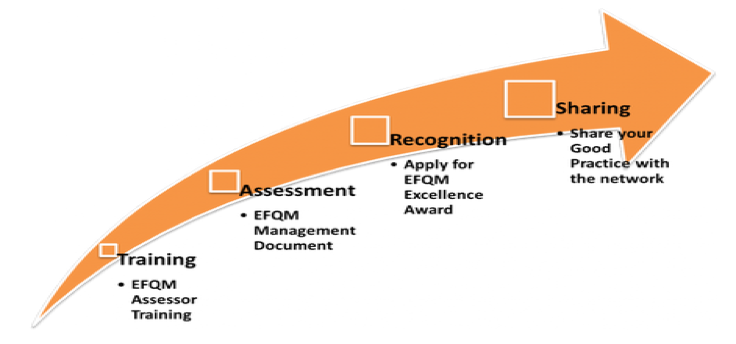
In summary
Baldrige is a proven, well established framework, with thirty years experience and thousands of organizations being familiar with its intent and structure. Can it ‘seize the day’, rise-up, perhaps in a different form and re-purpose itself? Can it promote its well-established criteria with a higher emphasis on ethics, social responsibility, customer and employee focus, continuous improvement and business results, but in more fluid, adaptive and technology enabled way? It has a rich history but if you look at the EFQM site you feel a more connected, engaged and determined organization pushing for you to seek out excellence.
Baldrige is a framework that warrants ongoing monitoring in the shifting world we live in, where global competition might be poised to pull back from global integration and re-establish National excellence and competitiveness, as organizations are encouraged to take more of the share of the markets in effective ways though the ability to show organization excellence and innovation that customers strongly relate too.
Sources of Reference
- https://www.nist.gov/baldrige
- https://www.nist.gov/baldrige/self-assessing/getting-started
- https://www.nist.gov/baldrige/publications
- https://www.nist.gov/baldrige/publications/baldrige-excellence-framework
- https://www.nist.gov/baldrige/baldrige-award
- https://www.nist.gov/baldrige/baldrige-award/award-process-fees
- https://www.nist.gov/baldrige/publications/baldrige-excellence-framework/businessnonprofit#busnonprofit
- https://www.nist.gov/baldrige/publications/baldrige-excellence-framework/health-care
- http://www.baldrigepe.org/
Europe
- http://www.efqm.org/
- http://www.efqm.org/the-efqm-excellence-model
- http://www.efqm.org/members-area/knowledge-base








